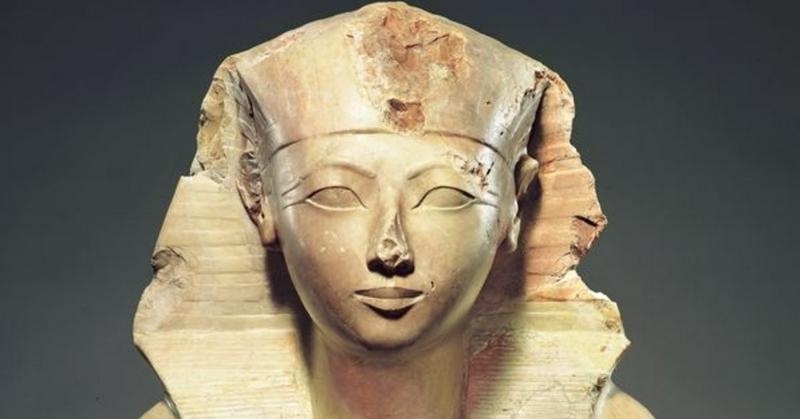Hatshepsut: The Woman Who Became An Ancient Egyptian Pharaoh (Killed By Her Nephew)
By | December 10, 2020

Cleopatra may have the name recognition when it comes to famous women of Ancient Egypt, but the path to the throne was paved by Hatshepsut. She reigned for close to 20 years during the 15th century B.C.E., a period known as the New Kingdom, but even though her time as pharaoh was long and filled with magnificent accomplishments, Hatshepsut was buried by history. Her significance wasn't uncovered until the 19th century, when she was seen more as a vile usurper than a celebrated ruler who led Egypt into peace and prosperity.
Born To Be A Regent
As the eldest of two daughters born to Thutmose I and his queen, Ahmes, 12-year-old Hatshepsut ascended to the throne as Queen of Egypt following the death of her father. At the time, she was married to her half-brother, Thutmose II, the son of her father and a member of his harem. Thutmose II died young, around 1479 B.C.E., and the throne was passed down to his infant son, Thutmose III, born to a secondary wife.
As was custom at the time, Hatshepsut reigned as Thutmose III's regent and handled affairs of state until he came of age. At least, that was the plan. At the onset of her time as regent, Hatshepsut performed her job diligently and without any excitement. She recognized her stepson as the one and only pharaoh, and that was that. Then, with no warning, Hatshepsut was crowned pharaoh, and Thutmosis III was left to languish in the background for the next 20 years.

Make-Pharaoh-Ver
The question of why Hatshepsut retained power is the subject of some debate among Egyptologists. Older researchers maintain that she usurped the throne out of nothing more than greedy ambition, but today's researchers believe it's more likely that Egypt faced a political crisis and Hatsheput had to act fast to save the throne for her branch of the royal family. It's possible that Thutmose I or II had more sons via their harems who had their eyes on the throne in its weakened state, so to secure the throne for her stepson, Hatshepsut did what she had to do.
To legitimize her rule, Hatshepsut made a controversial move that confounds Egyptologists to this day. While fighting to prove her royal lineage, she overhauled her image by ordering artists to portray her with ripped muscles and the traditional pharaonic false beard, decidedly masculinizing her appearance. She also made the smart move of surrounding herself with scholarly supporters in key roles of the government. Many researchers believe that Senenmut, her chief minister, was also her lover, but much like the belief that she stole the throne from her stepson, this claim of a secret male ruler behind the scenes is likely just another attempt to discredit the first female pharaoh.
During her two decades as pharaoh, Hatshepsut undertook a series of incredible building projects in and around Thebes, turning it into one of the most interesting places in Egypt. She erected a series of obelisks at the Palace of Ma'at, a rectangular structure made of small rooms with a large hall, the walls of which were covered with brightly painted relief scenes of Hatshepsut and Thutmose II. However, the most exciting architectural offering courtesy of Hatshepsut was the giant memorial temple Deir el-Bahri, a structure that's now considered one of the great achievements of Ancient Egypt. Hatshepsut also turned her kingdom into an economic powerhouse, undertaking a trading exposition with a land called Punt that brought ivory, ebony, gold, leopard skins, and incense into the country.
A legacy in shambles

Death Of A Pharaoh
After nearly 20 years of bringing economic prosperity to Egypt, Hatshepsut passed away in her mid-forties around 1458 B.C.E. She was buried in the Valley of the Kings, in the hills behind Deir el-Bahri, her greatest triumph, but not before she arranged for her father's sarcophagus to reburied in her tomb so they could be together in death.
Thutmose III followed in his stepsister's footsteps during his 30-year reign, becoming an economic and architectural powerhouse as well as a fierce warrior, but for reasons that no one quite understands, he did everything he could to destroy any evidence of Hatshepsut's reign toward the end of his life. Maybe he wanted to erase all proof of a powerful female ruler or close as much of the gap between his and his father's rule as possible. Whatever his reason, he didn't tell anyone inclined to write it down.
Even Hatshepsut's tomb was desecrated. When archaeologists unearthed a pit in the great temple complex at Deir el-Bahri in 1927, they noted that eyes were gouged out of statues, heads were chopped off, and the the cobra-like symbol of royalty was hacked from their foreheads. This lends some credence to the theory that Thutmose III ordered Hatshepsut's assassination, but at the moment, that's only speculation. It's just as likely that she passed away from natural causes or the use of a toxic skin cream.

Hatshepsut's Legacy
In 2007, Egyptian archaeologist Zahi Hawass theorized that a previously excavated royal mummy was none other than Hatshepsut, but many scholars are waiting for more evidence to back up this claim before they put their weight behind it. We'll likely never know the full story of Hatshepsut, and it's possible that she was all too aware of how likely she was to be forgotten, no matter how much she did for her people. Near the end of her life, she erected a second pair of obelisks at Karnak with an inscription that reads:
Now my heart turns this way and that, as I think what the people will say—those who shall see my monuments in years to come, and who shall speak of what I have done.

